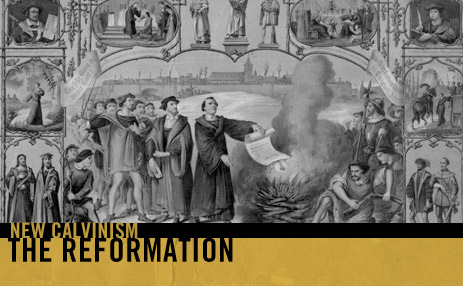Latest
-
Objections to the Christian Faith from the Unchurched and De-Churched
 Tue Dec 02, 2014
Tue Dec 02, 2014
by Resurgence -
Craig Groeschel: We Innovate for Jesus
 Tue Oct 14, 2014
Tue Oct 14, 2014
by Resurgence -
Mark Driscoll: Revelation
 Tue Oct 07, 2014
Tue Oct 07, 2014
by Resurgence -
RESURGENCE LEADERSHIP #034: JOHN PIPER, WHY I TRUST THE SCRIPTURES, PART 2
 Tue Sep 30, 2014
Tue Sep 30, 2014
by Resurgence -
Resurgence Leadership #033: John Piper, Why I Trust the Scriptures, Part 1
 Tue Sep 23, 2014
Tue Sep 23, 2014
by Resurgence

Archives
The Protestant Reformers on the Church
 The following is an excerpt from the book Vintage Church, which I wrote with Gerry Breshears (see pages 41–42, 44–45, 47): Catholicism in its various forms stresses the historical and institutional nature of the church. We see this in the official definition of the Catholic Church as found in the documents of Vatican II in chapter 1 of “The Dogmatic Constitution on the Church”: the church is defined as simultaneously “visible structure” and “the Mystical Body of Christ.” (Lumen Gentium) To further explain this, the document continues, “After his resurrection our Saviour handed her [the church] over to Peter to be shepherded (John 21:27), commissioning him and the other apostles to propagate and govern her. . . . This church, constituted and organized in the world as a society, subsists in the Catholic Church, which is governed by the successor of Peter and by the Bishops in communion with him.” The document goes on to explain how the church is to be organized. First, we are told that Jesus Christ appointed Peter to lead the apostles, granting to them special power and authority. Second, they then appointed bishops as their successors to continue this proverbial chain of command from one generation to the next, all the way to our present day. Third, the bishops appointed men as priests and deacons to assist them in ministry and “share the sacerdotal dignity” of the bishops and are granted special power, including the power to re-represent the sacrifice of Jesus Christ during the Mass. The leaders of the Protestant Reformation rejected the Roman Catholic definition of the church on many grounds:
The following is an excerpt from the book Vintage Church, which I wrote with Gerry Breshears (see pages 41–42, 44–45, 47): Catholicism in its various forms stresses the historical and institutional nature of the church. We see this in the official definition of the Catholic Church as found in the documents of Vatican II in chapter 1 of “The Dogmatic Constitution on the Church”: the church is defined as simultaneously “visible structure” and “the Mystical Body of Christ.” (Lumen Gentium) To further explain this, the document continues, “After his resurrection our Saviour handed her [the church] over to Peter to be shepherded (John 21:27), commissioning him and the other apostles to propagate and govern her. . . . This church, constituted and organized in the world as a society, subsists in the Catholic Church, which is governed by the successor of Peter and by the Bishops in communion with him.” The document goes on to explain how the church is to be organized. First, we are told that Jesus Christ appointed Peter to lead the apostles, granting to them special power and authority. Second, they then appointed bishops as their successors to continue this proverbial chain of command from one generation to the next, all the way to our present day. Third, the bishops appointed men as priests and deacons to assist them in ministry and “share the sacerdotal dignity” of the bishops and are granted special power, including the power to re-represent the sacrifice of Jesus Christ during the Mass. The leaders of the Protestant Reformation rejected the Roman Catholic definition of the church on many grounds:
- The church and its leaders and sacraments do not function between God and his people in a mediatorial manner, because in Scripture Jesus Christ alone is clearly said to be our only mediator and means of saving grace. First Timothy 2:5 says, “For there is one God, and there is one mediator between God and men, the man Christ Jesus.”
- There is no evidence anywhere in the New Testament that Jesus Christ or his apostles called the church into being with such a rigidly structured institutional hierarchy as purported by Catholicism.
- There is no evidence anywhere in the New Testament that the apostles appointed bishops.
- Outside of Scripture the history of the early church flatly denies that it organized itself in the manner described by the Roman Catholic Church.
- The entire concept of the Roman Catholic priesthood contradicts the repeated New Testament teaching that in the new covenant there is not a special office of priest but rather a special priesthood (1 Pet. 2:5–9). As this priesthood, believers have direct access to God the Father through God the Son by God the Spirit (Rom. 5:1–2; Eph. 2:18), live lives of worship as sacrifices to God (Rom. 12:1), hear the confessions of one another’s sin (James 5:16), and give spiritual guidance and counsel (Col. 3:16).
- The idea that the appointed leaders and members of the Roman Catholic Church were godly followers and obedient servants of Jesus Christ as the true church on earth simply contradicts even the Roman Catholic Church’s historical record, as many leaders were godless men who served out of political and not spiritual motivation. . . .
As a result, the Reformers defined the church in terms of the presence of the gospel of Jesus Christ. Perhaps the most famous Protestant definition of the church is from John Calvin, who said, “Wherever we see the Word of God purely preached and heard, and the sacraments administered according to Christ’s institution, there, it is not to be doubted, a church of God exists” (Institutes of the Christian Religion). The same definition with minor alterations appears in many strands of Protestantism, including the Lutheran Augsburg Confession (1530), the Forty-two Articles of the Church of England (1553), and the Belgic Confession of 1561. Today, the ongoing legacy of the Reformers’ view of the church as found in Scripture continues wherever the true church meets around the true gospel.